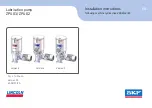
Chapter 4
Theory of Operation
©
National Instruments Corporation
4-7
DAQCard-1200 User Manual
The programmable gain amplifier applies gain to the input signal, allowing
an analog input signal to be amplified before being sampled and converted,
thus increasing measurement resolution and accuracy. The instrumentation
amplifier gain is software-selectable. The DAQCard-1200 provides gains
of 1, 2, 5, 10, 20, 50, and 100.
The dither circuitry, when enabled, adds approximately 0.5 LSB rms of
white Gaussian noise to the signal to be converted to the ADC. This
addition is useful for applications involving averaging to increase the
resolution of the DAQCard-1200 to more than 12 bits, as in calibration.
In such applications, which are often lower frequency in nature, noise
modulation is decreased and differential linearity is improved by the
addition of the dither. For high-speed 12-bit applications not involving
averaging, dither should be disabled because it only adds noise.
When taking DC measurements, such as when calibrating the
DAQCard-1200, enable dither and average about 1,000 points to take a
single reading. This process removes the effects of 12-bit quantization and
reduces measurement noise, resulting in improved resolution. Dither, or
additive white noise, has the effect of forcing quantization noise to become
a zero-mean random variable rather than a deterministic function of input.
The DAQCard-1200 uses a 12-bit successive-approximation ADC. The
12-bit resolution of the converter allows the converter to resolve its input
range into 4,096 different steps. The ADC has an input range of ±5 V and
0 to 10 V.
When an A/D conversion is complete, the ADC clocks the result into the
A/D FIFO. This FIFO serves as a buffer to the ADC. The A/D FIFO can
collect up to 1,024 A/D conversion values before any information is lost,
thus allowing software some extra time to catch up with the hardware. If
you store more than 1,024 samples in the A/D FIFO before reading from
the A/D FIFO, an error condition called
A/D FIFO overflow
occurs and you
lose A/D conversion information.
The output from the ADC can be interpreted as either straight binary or
two
’
s complement format, depending on which input mode you select
(unipolar or bipolar). In unipolar mode, the data from the ADC is
interpreted as a 12-bit straight binary number with a range of 0 to +4,095.
In bipolar mode, the data from the ADC is interpreted as a 12-bit two
’
s
complement number with a range of
–
2,048 to +2,047. In this mode, the
MSB of the ADC result is modified to make it two
’
s complement. The
output from the ADC is then sign extended to 16 bits, causing either a
leading 0 or a leading F (hex) to be added, depending on the coding and the
sign. Thus, data values read from the FIFO are 16 bits wide.
Summary of Contents for DAQPad-1200
Page 1: ...DAQPad 1200...
















































